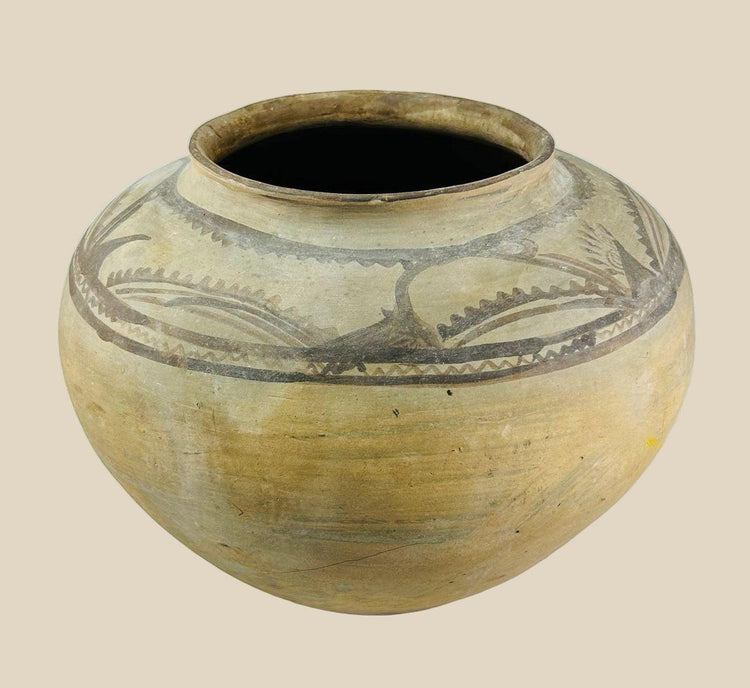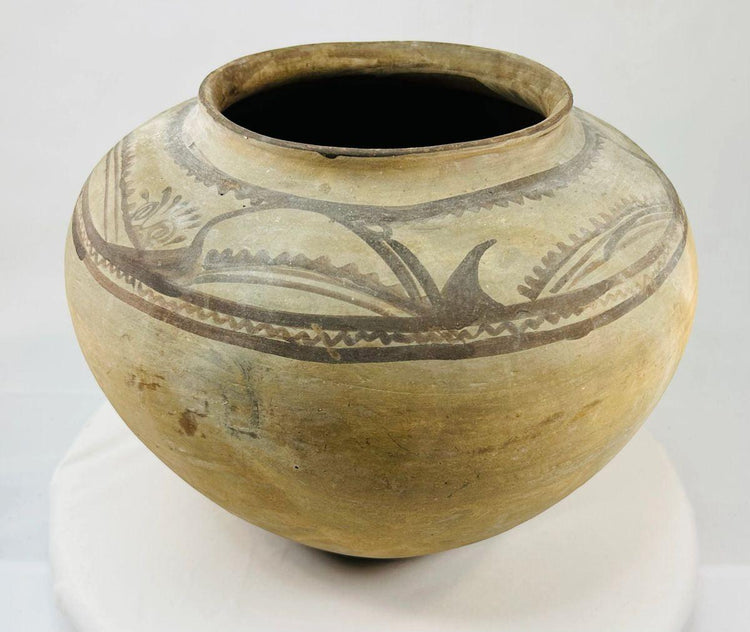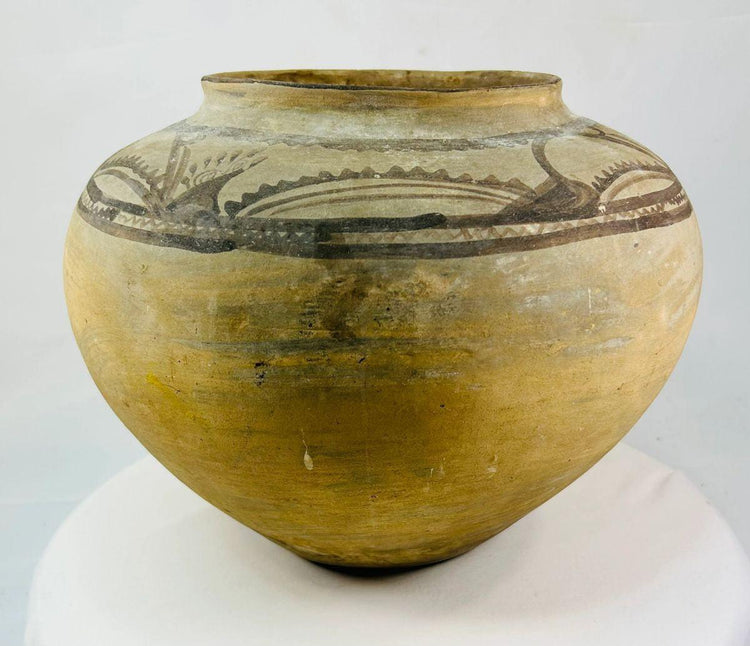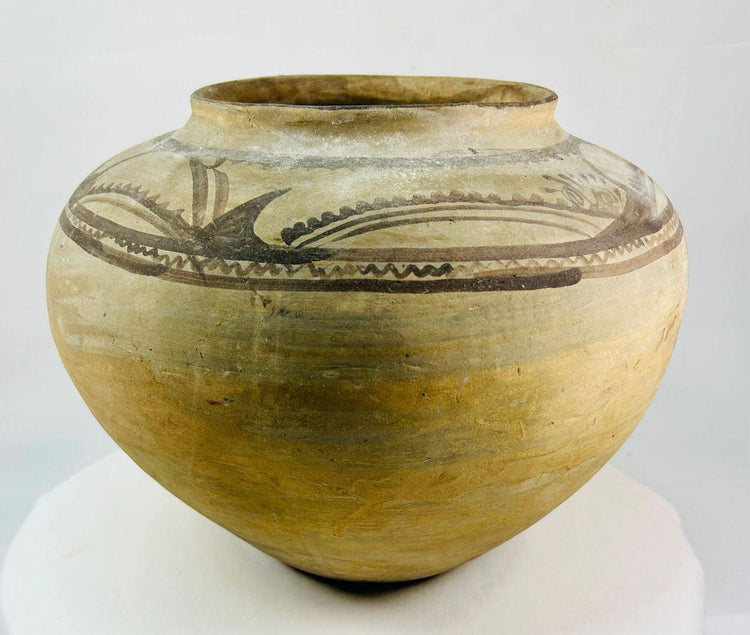Early European Neolithic Vessel | Hand-Molded Terracotta with Painted Slip | Circa 5500–4500 BCE
Description
More
Less
Historical Context & Origin
Region: Central or Southeastern Europe, likely Linear Pottery Culture (LBK) or Vinca Culture
Material: Hand-molded terracotta with painted slip decoration
Period: Neolithic Era, circa 5500–4500 BCE
Description
This large Neolithic painted pottery jar is a rare survival from early European prehistory, reflecting the artistry and ritual life of the first agricultural societies. Its bulbous body, narrow neck, and wide rim suggest it was used for communal storage or ceremonial offerings. The jar is decorated with painted spirals, floral motifs, and geometric designs, symbolizing fertility, growth, and the cyclical nature of life—motifs central to Neolithic spiritual belief systems. Measuring 8.5 inches high by 10.5 inches wide, the vessel represents both functional utility and symbolic meaning within early village communities.
Features
- Painted decoration with spirals, floral, and geometric motifs
- Symmetrical bulbous body with narrow neck and wide rim
- Handmade terracotta construction with visible traces of shaping and slip application
- Representative of Linear Pottery or Vinca cultural traditions
Cultural Significance
Pottery was at the heart of Neolithic life, serving both practical and ceremonial roles. Vessels such as this were often used to store grain, liquids, or offerings tied to fertility and seasonal cycles. The painted motifs represent early symbolic communication, linking artistic expression to spiritual life. As one of the oldest known ceramic traditions in Europe, jars of this type are vital to understanding the development of settled agricultural societies and their religious practices.
Condition
The vessel remains in very good archaeological condition, with natural surface wear consistent with its extreme age. The terracotta body shows stable mineral patina and minor chipping along the rim. Painted decoration remains faint but discernible, providing evidence of its symbolic role. Despite its antiquity, the jar retains its full form with no modern restorations, making it both stable and display-worthy.
Dimensions (approximate)
Height: 8.5 in
Width: 10.5 in
Age
Approximately 7,000 years old
Description
Historical Context & Origin
Region: Central or Southeastern Europe, likely Linear Pottery Culture (LBK) or Vinca Culture
Material: Hand-molded terracotta with painted slip decoration
Period: Neolithic Era, circa 5500–4500 BCE
Description
This large Neolithic painted pottery jar is a rare survival from early European prehistory, reflecting the artistry and ritual life of the first agricultural societies. Its bulbous body, narrow neck, and wide rim suggest it was used for communal storage or ceremonial offerings. The jar is decorated with painted spirals, floral motifs, and geometric designs, symbolizing fertility, growth, and the cyclical nature of life—motifs central to Neolithic spiritual belief systems. Measuring 8.5 inches high by 10.5 inches wide, the vessel represents both functional utility and symbolic meaning within early village communities.
Features
- Painted decoration with spirals, floral, and geometric motifs
- Symmetrical bulbous body with narrow neck and wide rim
- Handmade terracotta construction with visible traces of shaping and slip application
- Representative of Linear Pottery or Vinca cultural traditions
Cultural Significance
Pottery was at the heart of Neolithic life, serving both practical and ceremonial roles. Vessels such as this were often used to store grain, liquids, or offerings tied to fertility and seasonal cycles. The painted motifs represent early symbolic communication, linking artistic expression to spiritual life. As one of the oldest known ceramic traditions in Europe, jars of this type are vital to understanding the development of settled agricultural societies and their religious practices.
Condition
The vessel remains in very good archaeological condition, with natural surface wear consistent with its extreme age. The terracotta body shows stable mineral patina and minor chipping along the rim. Painted decoration remains faint but discernible, providing evidence of its symbolic role. Despite its antiquity, the jar retains its full form with no modern restorations, making it both stable and display-worthy.
Dimensions (approximate)
Height: 8.5 in
Width: 10.5 in
Age
Approximately 7,000 years old
You May Also Like




















